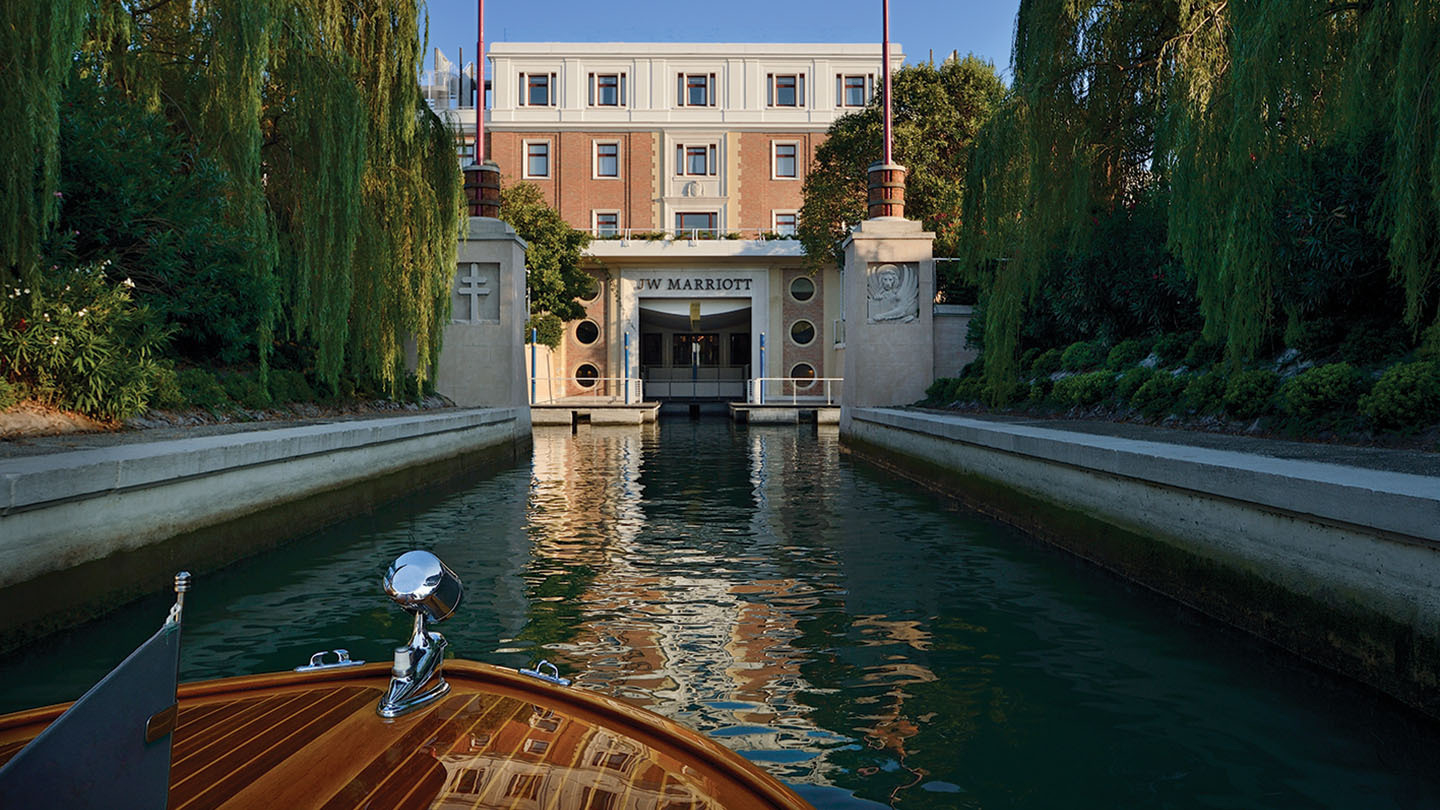Many words have been written about Venice: the art, the music, the water, the tiny streets, the fading brickwork… It’s a romantic city-breakers’ dream, but when the hussle and noise (and the tourists) become too much, take a sleek complimentary shuttle service (boat ride) to the JW Marriott at Isola delle Rose, Laguna di San Marco. In the 18th Century, the private island in the Venetian lagoon was a place of convalescence for people with pulmonary illnesses; now it’s a resort destination that’s home to Venice’s largest spa.
In contradiction to Venice’s lavish façade, the design of JW Marriott and Goco Spa are simple, with neutral palettes, clean lines and large windows -- many with views over the Venice skyline. Designed by Italian architect Matteo Thun in a minimalist style that captures the light of the lagoon and private gardens.
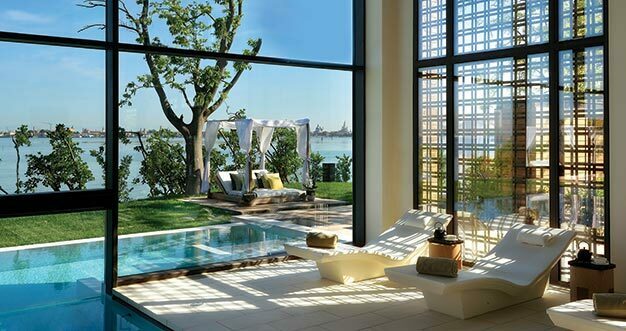
What’s on offer?
The hotel is huge with four restaurants, three bars, three pools, an olive grove and large gardens. The spa is an enclave of calm (there’s an additional cost to use the spa so it remains quiet). It’s a short walk from the main hotel, or arrive to check-in like the Venetians -- by boat from St. Mark's Square. The building is double height, the reception soaring high into the rafters with many circular glass lights suspended from the ceiling. Latticework runs over each of the windows and glass doors, casting interesting shadows on the marble floors.
The changing rooms are in the basement and are petit but well-designed with large lockers and separate showers and WCs. There’s a waiting area with soft armchairs; cushions provide splashes of colour in the pale green room. Choose a tea from the menu including ‘Greek Detox’ and ‘Latin Power’ or top up with water; come summer, you’ll need to stay hydrated.
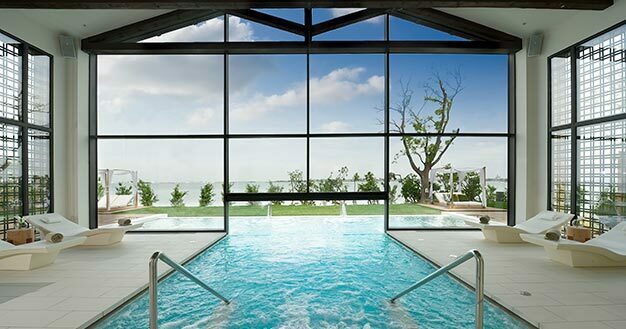
The large indoor/outdoor pool is the hub of the wellness spa - drift in the water while gazing out at the city of romance. Ten bubble stations will massage your legs, shoulders and back, or simply lay back on the Jacuzzi-style beds. The hot Finnish sauna has a wall of Himalayan sea salt; the bio-sauna is temperate with traditional wooden seating and wooden beds, while the green and gold tiled hammam has seating areas and a central circular plinth.
Visit in the summer and there are many seats, loungers and even cabanas in the pretty spa garden. You can book in for yoga, Pilates or meditation classes here, or there’s a fitness studio if you like to exercise around your spa-time.
The spa offers QMS facials in the beauty treatment rooms above the pool, while more traditional treatments are performed in rooms next to the main spa building, each with its own pretty garden.

Tell us about the treatments
QMS was founded by cosmetic surgeon Erich Schulte, who created products for his own patients and then made them more widely available. Expect ingredients like soluble collagen, fruit acids and oxygen therapy.
We had the Activ-Collagen Facial with a Rose Eye Reviver. My therapist, Erika, explained the treatment; she would be using three different masks and two tools including an oxygen spray. I settled on the warm treatment bed overlooking the pool area, while Erika made sure I was warm enough.
She started the treatment with a deep cleanse and then applied the first mask: a fruit acid peel. It tingled but wasn’t uncomfortable; after a few minutes she applied a gentle exfoliating cream on top to calm the sensation. She removed the products, used a steam machine to open my pores and tackled my clogged skin through manual extractions. Next was a very thick, cool algae mask which covered my entire face including my eyes and mouth. It set very quickly, capturing my skin’s many flaws. Yikes!
Erika got out her second gadget: an oxygen therapy machine which blows pure oxygen and hyaluronic acid onto the skin. It felt very cold but, again, not uncomfortable. The final mask of the facial was the ‘plaster modelage’: Erika smoothed on cream and then stretched strips of fabric (almost like bandages) over my face. While this set, she massaged my hands and arms. Erika asked me to smile to lift the fabric, and then peeled the modelage off my face. To finish, she applied moisturisers to my eyes and skin.
Was it all worth it? Definitely. My dehydrated skin looked and felt softer, and the angry red marks from blemishes were calmer. My skin felt like it could drink in the fresh island air.
At Goco Spa you can also have Amala massages and organic facials, manicures and pedicures and body treatments including a hammam ritual.
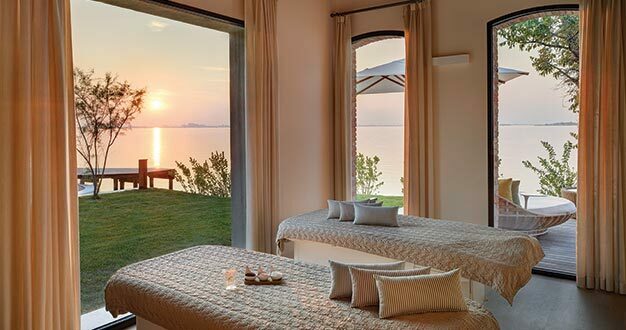
Food facts
You can eat in the spa with its selection of healthy meals including salads, sandwiches and antipasti. If you’re looking for formal fine dining, visit the Michelin starred Fiola at Dopolavoro Venezia, led by Michelin-starred Chef Fabio Trabocchi. Or for more informal food head up to the Italian speciality restaurant Sagra and the rooftop terrace with a bar and adult-only roof top pool overlooking the city. Grab a Spritz, Venice’s favourite aperitif, and soak up the sunshine. We tried the Sagra restaurant and loved our Linguini di Mare and Fettuccini.
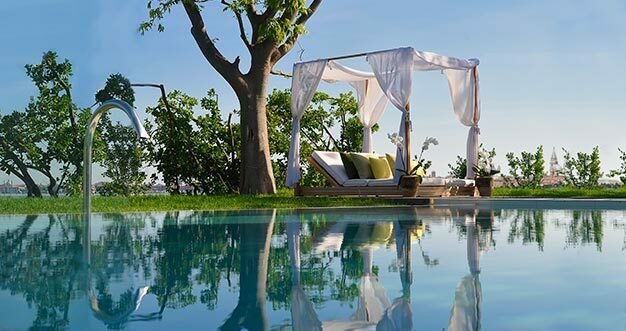
Who would like it?
A young-ish age range: People in their 20s, 30s and 40s, especially young families as there are plenty of facilities and activities to keep children occupied (and happy).
Foodies: The Sapori Cooking Academy has two-hour classes every day, or book in for an eight-hour course and visit the Rialto fish restaurant with a chef.
Don’t miss:
The spa suite: The double treatment room has a lovely garden running down to the waterfront.
Find out more. Room rates start at €290. Access to spa facilities for hotel guests are €35 for up to three hours. Easily accessible from Venice Marco Polo airport.

Summer Spy
9th May 2017
Spy Likes:
Warmth and sunshine; spas which take me away to another country; fruit infused waters; beach-worth pedicures; deep tissue massages.
Spy Dislikes:
High footfalls; treatments that over promise and under deliver; heavy lunches; loungers drapped in used towels.
